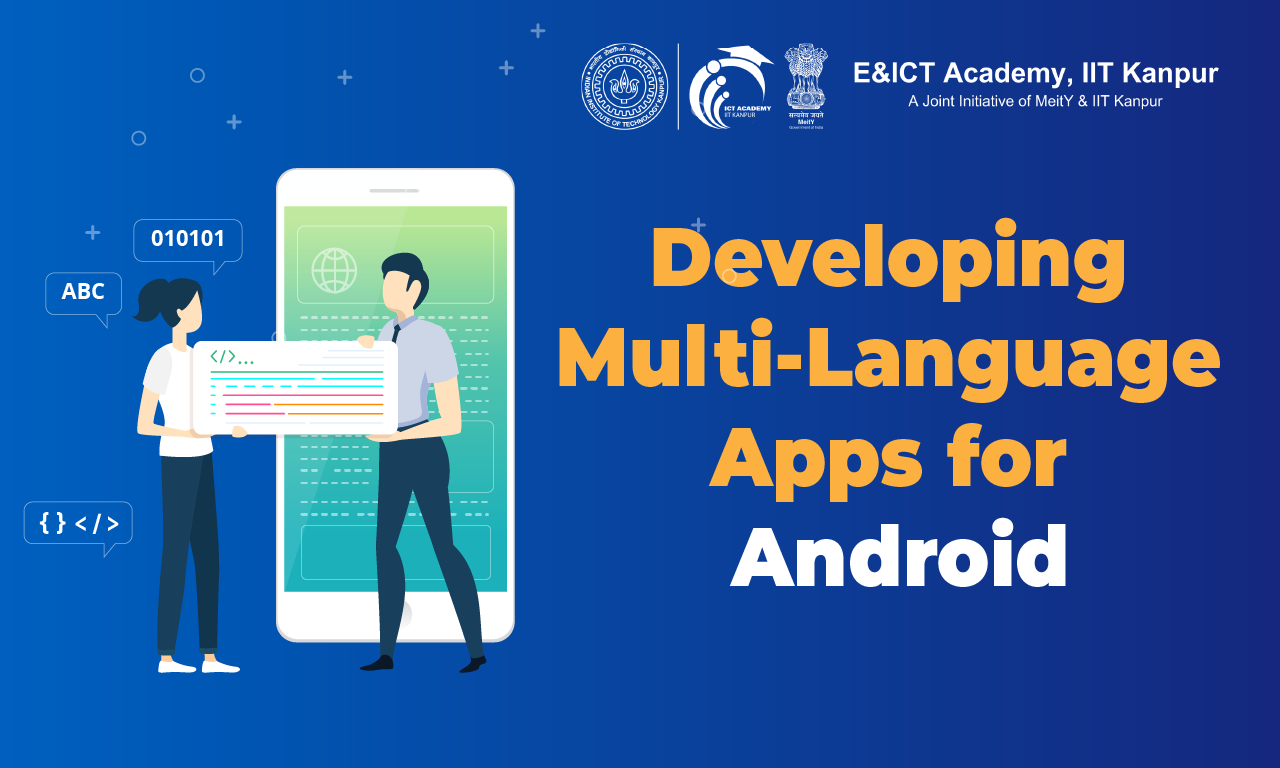Developing Multi-Language Apps for Android

Developing a multi-language app for Android involves considering several key aspects. Here’s a step-by-step points :
Planning:
- Determine the languages you want to support in your app. Identify your target audience and select languages accordingly.
- Decide whether you want to provide translations for the app’s content or rely on user-generated translations.
- Consider the layout and design of your app to accommodate different languages’ text lengths and character sets.
Internationalisation (i18n):
- Ensure that your app’s codebase is prepared for localization by externalising all user-facing strings and resources.
- Replace hard-coded strings with string resource references.
- Separate any language-specific formatting, such as dates, times, and numbers, using appropriate APIs.
- Avoid using images containing text to make localization easier.
Localization (L10n):
- Create language-specific resource files for each supported language. Android uses language codes (e.g., “en” for English, “es” for Spanish) to identify these resources.
- Store translated strings, images, and other resources in the appropriate language-specific resource files.
- Use the correct encoding for text resources to support different character sets.
- Consider using professional translators or translation services for accurate translations.
Implementing language selection:
- Provide a user interface to allow users to select their preferred language.
- Store the user’s language preference and make it persistent across app sessions.
- Update the app’s locale based on the user’s language selection to display the appropriate translations.
Testing:
- Thoroughly test your app in each supported language to ensure the translations are accurate and properly displayed.
- Pay attention to text length, font sizes, and layout adjustments needed for different languages.
- Test language-specific features, if any, to ensure they function correctly in each language.
Continuous improvement:
- Gather user feedback regarding the translations and address any issues or suggestions for improvement.
- Keep your language resources up to date and add new translations as needed.
- Stay updated with the latest Android development practices and tools related to localization.
Right-to-Left (RTL) support:
- If you plan to support languages that are written from right to left (such as Arabic or Hebrew), implement RTL support in your app.
- Ensure that your app’s layout and UI elements adjust properly for RTL languages.
- Test the app thoroughly in RTL mode to verify that text alignment, padding, and other visual elements are correctly mirrored.
Translating app store listings and content:
- Translate your app’s metadata, including app name, description, and keywords, for each language you support.
- Localize any promotional materials, screenshots, or videos used in app store listings to appeal to users in different regions.
- Adapt marketing content and messages to suit the cultural and linguistic nuances of the target languages.
Update resource files:
- Place the translated strings in the corresponding resource files. Each language should have its own set of translated strings.
- Be sure to maintain the original structure and formatting of the strings.
Handling dynamic content and user-generated data:
- If your app includes user-generated content, such as comments, reviews, or user profiles, provide mechanisms for translating or displaying that content in the user’s chosen language.
- Consider employing machine translation or community-based translation approaches to handle dynamic content in real-time.
Accessibility considerations:
- Ensure that your app remains accessible in all supported languages.
- Accommodate different screen reader languages and support localized accessibility features.
- Verify that the translations maintain accessibility guidelines, such as using clear and concise language and providing alternative text for images.
Regular updates and maintenance:
- Keep track of updates to Android’s localization tools, libraries, and best practices.
- Continuously monitor user feedback and reviews to address any localization issues or user concerns promptly.
- As you add new features or make changes to your app, ensure that they are properly localized and tested in all supported languages.
Error handling and messaging:
- Ensure that error messages and notifications in your app are properly localized to provide clear instructions or explanations in each supported language.
- Pay attention to any specific cultural or linguistic considerations when crafting error messages to ensure they are appropriate and understandable across different languages.
Localization testing:
- Perform thorough localization testing to verify the accuracy of translations and to identify any issues related to text truncation, formatting, or layout.
- Test your app on devices with different screen sizes, resolutions, and Android versions to ensure consistent behavior across various configurations.
Time and date formats:
- Localize time and date formats according to the conventions of each supported language or region.
- Utilize Android’s built-in APIs for formatting dates, times, and calendars to handle these differences accurately.
Handling localization updates:
- When you make updates to your app, such as adding new features or modifying existing ones, ensure that the changes are reflected in all supported languages.
- Keep track of changes that require updates in language-specific resources, including string values, images, or localized content.
Community involvement:
- Consider involving the community of users who speak the supported languages in the translation process.
- Provide mechanisms for users to suggest corrections or improvements to translations, fostering a collaborative approach to localization.
App size optimization:
- Take care to optimize the size of your app, especially when including multiple language resources.
- Explore techniques such as using APK splits or dynamic delivery to reduce the overall size of the app while allowing users to download only the necessary language resources.
Continuous localization feedback loop:
- Maintain an open channel for receiving feedback from users regarding translations, localization issues, or missing content.
- Regularly update your language resources based on user feedback and make sure to address any reported issues promptly.
App analytics and user behavior:
- Implement analytics tools within your app to track user behavior and engagement across different languages.
- Monitor usage patterns and metrics specific to each language to gain insights into user preferences and make data-driven decisions for localization improvements.
Local regulations and legal considerations:
- Be aware of local regulations and legal requirements specific to each region or language you support.
- Ensure that your app complies with privacy laws, data protection regulations, and any other legal obligations relevant to the target languages or regions.
Support and customer service:
- Provide multilingual customer support to address user inquiries and issues in their preferred language.
- Offer clear instructions and resources in each supported language to assist users with common troubleshooting steps or frequently asked questions.
App updates and version control:
- Maintain a streamlined process for updating and managing language resources when releasing new app updates.
- Utilize version control systems to keep track of changes to language-specific files and ensure consistency across different app versions.
Collaboration with translators:
- Foster a collaborative relationship with translators or translation agencies by providing them with context and guidelines for accurate and contextually appropriate translations.
- Establish a communication channel to address questions, clarify any ambiguities, and provide feedback on translations.
Localizing user interfaces and graphics:
- Pay attention to the cultural context when localizing UI elements, icons, and graphics.
- Use appropriate symbols, colors, and visual elements that resonate with the target audience to ensure a visually appealing and culturally relevant user experience.
Accessibility considerations for language-specific features:
- If your app includes language-specific features, ensure that they are accessible and usable for users with different language backgrounds.
- Test these features thoroughly to ensure they work as intended across all supported languages.
Text expansion and contraction:
- Account for text expansion and contraction that may occur when translating your app’s content into different languages.
- Design your UI in a way that accommodates varying text lengths without causing layout issues or text truncation.
Cultural adaptation:
- Ensure that your app’s content and features are culturally sensitive and appropriate for each target language or region.
- Pay attention to cultural nuances, customs, and preferences when designing user interfaces, selecting images, or presenting content.
Localization readiness during development:
- Incorporate localization considerations throughout the development process, rather than treating it as an afterthought.
- Use placeholders or dummy text in your UI during development to ensure that the layout is flexible and adaptable to different text lengths.
Contextual translation:
- Provide context to translators when sharing strings or content for translation.
- Clarify the purpose and usage of each string to help translators understand the appropriate translation in different contexts.
Incremental localization:
- Consider releasing your app with partial translations if you are unable to provide complete translations for all languages at once.
- Prioritize translations for critical user-facing elements and progressively add translations in subsequent updates.
Quality assurance and bug fixing:
- Establish a thorough quality assurance process to identify and fix any language-specific bugs, display issues, or translation errors.
- Encourage users to provide feedback on language-related problems to help you quickly address and resolve them.
Considerations for different writing systems:
- If your app supports languages with non-Latin scripts, such as Chinese, Japanese, or Arabic, ensure that your UI and text rendering can handle these writing systems correctly.
- Pay attention to font choices, character spacing, and text rendering options to maintain readability and legibility.
Localization automation and tools:
- Explore automation tools and frameworks that can assist in the localization process, such as string extraction, translation management systems, or translation memory tools.
- These tools can help streamline the localization workflow and improve efficiency, especially when working with a large number of languages or frequent updates.
Beta testing and user feedback:
- Conduct beta testing with users who speak the supported languages to gather feedback and identify any localization issues or usability concerns.
- Actively listen to user feedback and make necessary improvements based on their suggestions and observations.



